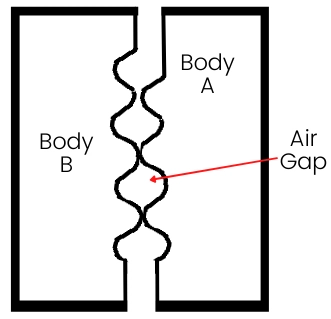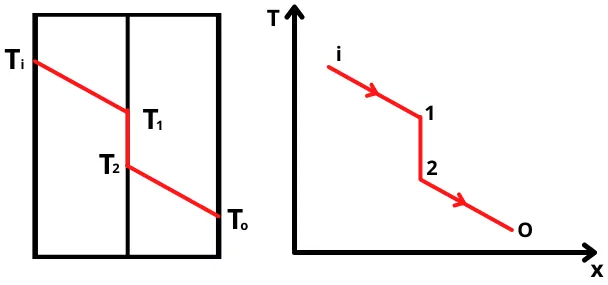Contents:
What is Thermal contact resistance in heat transfer?
Thermal contact resistance is the resistance to the conduction heat transfer between surfaces of two contacting bodies. This resistance arises due to improper contact between two bodies due to irregularities like scratches, ruptures, or dirt on the surface. It causes less contact area available for heat conduction.
In solid material, heat is transferred due to the lattice vibrations and due to the transfer of free electrons.
It means that heat conduction in solids takes place at a molecular level. As the molecules get closer, there will be a greater transfer of heat.
But when two separate bodies come in contact, they never form such closer contact over the whole surface. Due to the surface irregularities, the air or any gas is filled between these gaps which act as insulation for conduction.
Thus it resists heat conduction among them. This resistance to the heat conduction per unit contacting area is the contact resistance.
Causes of Thermal contact resistance:
The thermal contact resistance depends on the following factors:
1] Surface finishing:
The surfaces of the mating bodies which look smooth in visual inspection have irregularities on a microscopic level. The above figure shows the microscopic view of contacting surfaces.

As shown in the figure, the surface of the bodies has a crest and valley, therefore the two bodies contact each other at some portions while in the remaining portion, the air gap is present.
This air gap has comparatively low thermal conductivity, therefore it adds extra resistance to the flow of heat. This resistance per unit area of contacting surface is known as Thermal contact resistance.
2] Surface cleanliness:
Unclean surfaces can increase contact resistance in two ways;
It acts as an obstruction and reduces the direct contact between surfaces.
DIrt with poor thermal conductivity resists heat transfer.
3] Contact pressure:
Loosely bound surfaces have very less contact with each other, which increases the presence of void spaces between contacting surfaces. Thus very less surface is available for heat transfer by conduction.
Increasing contact pressure forces the surfaces to create more contact with each other and reduces the voids. That helps to boost the conduction of heat.
Formula of the Thermal contact resistance:

The thermal contact resistance (TCR) for the two contacting surfaces is given by the ratio of temperature difference at the contact of two bodies to the rate of heat flux (q).
Mathematically, the TCR formula is given by,
`R_{TC}=\frac{T_{1}-T_{2}}{q}`
Thermal contact resistance units:
SI unit:–
In the SI system, the unit of temperature is K, and the unit of heat flow rate is W/m².
`\therefore R_{TC}=\frac{\Delta T}{q}=\frac{K}{\frac{W}{m^{2}}}= \text{K.m²/W}`
∴ The SI unit is K.m2/W
FPS unit:–
In an FPS system, the unit of temperature is °F and the unit of heat flow rate is BTU/ft².hr.
`\therefore R_{TC} = \frac{\Delta T}{q}=\frac{°F}{\frac{Btu}{ft^{2}.hr}}= ° F.ft^{2}. \text{hr/Btu}`
∴ FPS unit is °F.ft2.hr/Btu.
How to reduce Thermal contact resistance?
Here are some methods that will help to reduce TCR:-
- Make the contacting surface highly polished which reduces the air gap between the two bodies.
- Clean the mating surfaces to create direct contact between surfaces.
- The application of pressure on contacting bodies helps to improve contact between two bodies.
- An increase in the pressure of ambient gas present in gaps helps to reduce contact resistance.
- Removing the air gap by application of high thermal conductivity grease between the contacting surfaces. It reduces the contact resistance and improves heat conduction.
FAQs:
-
What is effect of thermal contact resistance on heat transfer?
Contact resistance reduces the direct contact between the surfaces, causing less contact area available for the direct conduction of heat.
-
How can I reduce thermal contact resistance?
The thermal contact resistance can be reduced by following techniques:
Use highly polished surfaces
Cleaning of surfaces
Use of high-conductivity fluids
Increasing the contact pressure
Related articles:
the Temp of T1 and T2 are unknow ? how do we calculate the thermal resistance between the two layers at the interface between them ?
If you have thermal conductivity (K) for material A and B, Thickness (X_(A) & X_(B)), and amount of heat flux (q) then you can find the interface temperature T_(1) and T_(2) by Fourier equation for conduction as,
q = [T_(i) – T_(1)]/[(L_{Surface A})/(K_{Surface A})]
q = [T_(2) – T_(o)]/[(L_{Surface B})/(K_{Surface B})]
Now by using these temperatures T_(1) and T_(2) you can find contact resistance.